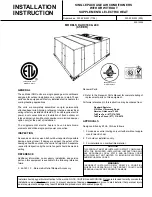
21
GB
11.3. Wiring transmission cables
1
Types of control cables
1. Wiring transmission cables
Types of transmission cables: Shielding wire CVVS, CPEVS or MVVS
Cable diameter: More than 1.25 mm
2
[AWG 16]
Maximum wiring length: Within 200 m [656 ft]
Maximum length of transmission lines for centralized control and indoor/outdoor transmission lines (Maximum length via outdoor units): 500 m [1,640 ft] MAX
The maximum length of the wiring between power supply unit for transmission lines (on the transmission lines for centralized control) and each outdoor unit and
system controller is 200 m [656 ft].
2. Remote control cables
Transmission cables (Li)
M-NET remote controller cables
MA Remote controller cables
Type of cable
Shielding wire (2-core)
CVVS, CPEVS or MVVS
Sheathed 2-core cable (unshielded) CVV
Cable size
More than 1.25 mm
2
[AWG16]
0.3 ~ 1.25 mm
2
[AWG22 ~ 16]
(0.75 ~ 1.25 mm
2
[AWG18 ~ 16]) (*1)
0.3 ~ 1.25 mm
2
[AWG22 ~ 16] (*2)
Remarks
Max length: within 200 m
When 10 m [32ft] is exceeded, use cables with
WKHVDPHVSHFL¿FDWLRQDVWUDQVPLVVLRQFDEOHV
Max length: 200 m [656ft] (*3)
*1 Connected with PZ-52SF.
*2 To wire PAR-31MAA(E), Simple MA remote controller use a wire with a
diameter of 0.3 mm
2
[AWG22]
*3 When a PAR-31MAA(E) and other MA remote controllers are connected
inthe same group, the maximum length of cable should be 100 m.
CVVS, MVVS: PVC insulated PVC jacketed shielded control cable
CPEVS: PE insulated PVC jacketed shielded communication cable
CVV: PV insulated PVC sheathed control cable
2
Wiring examples
Controller name, symbol and allowable number of controllers.
Name
Code
Possible unit connections
Outdoor unit
Main unit
OC
– (*2)
Sub unit
OS1, OS2
– (*2)
Indoor unit
Indoor unit controller
IC
1 to 26 units per 1 OC (*1)
Remote controller
Remote controller (*1)
RC
2 units maximum per group (*3)
Other
Transmission booster unit
RP
0 to 1 unit per 1 OC (*1)
*1 A transmission booster (RP) may be required depending on the number of connected indoor unit controllers.
*2
2&26DQG26RIWKHRXWGRRUXQLWVLQWKHVDPHUHIULJHUDQWV\VWHPDUHDXWRPDWLFDOO\LGHQWL¿HG7KH\DUHLGHQWL¿HGDV2&26DQG26LQGHVFHQGLQJRUGHURIFDSDFLW\
(If the capacity is the same, they will be in ascending order of their address number.)
*3 When a PAR-31MAA is connected to a group, no other MA remote controllers can be connected to the same group.
1
Connect the indoor-outdoor transmission cable to TB3.
If multiple outdoor units are connected to the same refrigerant system, daisy-chain TB3 (M1, M2, ground) on the outdoor units. The indoor-outdoor transmission cable
to the indoor unit should be connected to TB3 (M1, M2, ground) of only one of the outdoor units. Connect the shield to the ground terminal.
2
Connect the centralized control transmission cables (between the centralized control system and the outdoor units of different refrigerant systems) to TB7.
If multiple outdoor units are connected to the same refrigerant system, daisy-chain TB7 (M1, M2, S) on all outdoor units.*
1
Connect the shield to the S terminal.
*1 : If TB7 on the outdoor units in the same refrigerant system are not daisy-chained, connect the centralized control transmission cable to TB7 on the OC. If the OC
is out of order, or if centralized control is being conducted during a power supply shut-off, daisy-chain TB7 on the OC and OS. (In the case that the outdoor unit
whose power jumper CN41 on the control board has been replaced with CN40 is out of order or the power is shut-off, centralized control will not be conducted
even when TB7 is daisy-chained.)
3
When a power supply unit is not connected to the centralized control transmission cable, move the power jumper from CN41 to CN40 on only one of the outdoor
units.
4
On the outdoor unit whose power jumper was moved from CN41 to CN40, short circuit the S terminal and the ground terminal.
5
Connect terminals M1 and M2 of the transmission terminal block on the indoor unit that has the lowest address in the group to the terminal block on the remote
controller.
6
When a system controller is connected, set SW5-1 on all outdoor units to ON.
7
Fix the cables securely in place with the cable strap below the terminal block.
















































